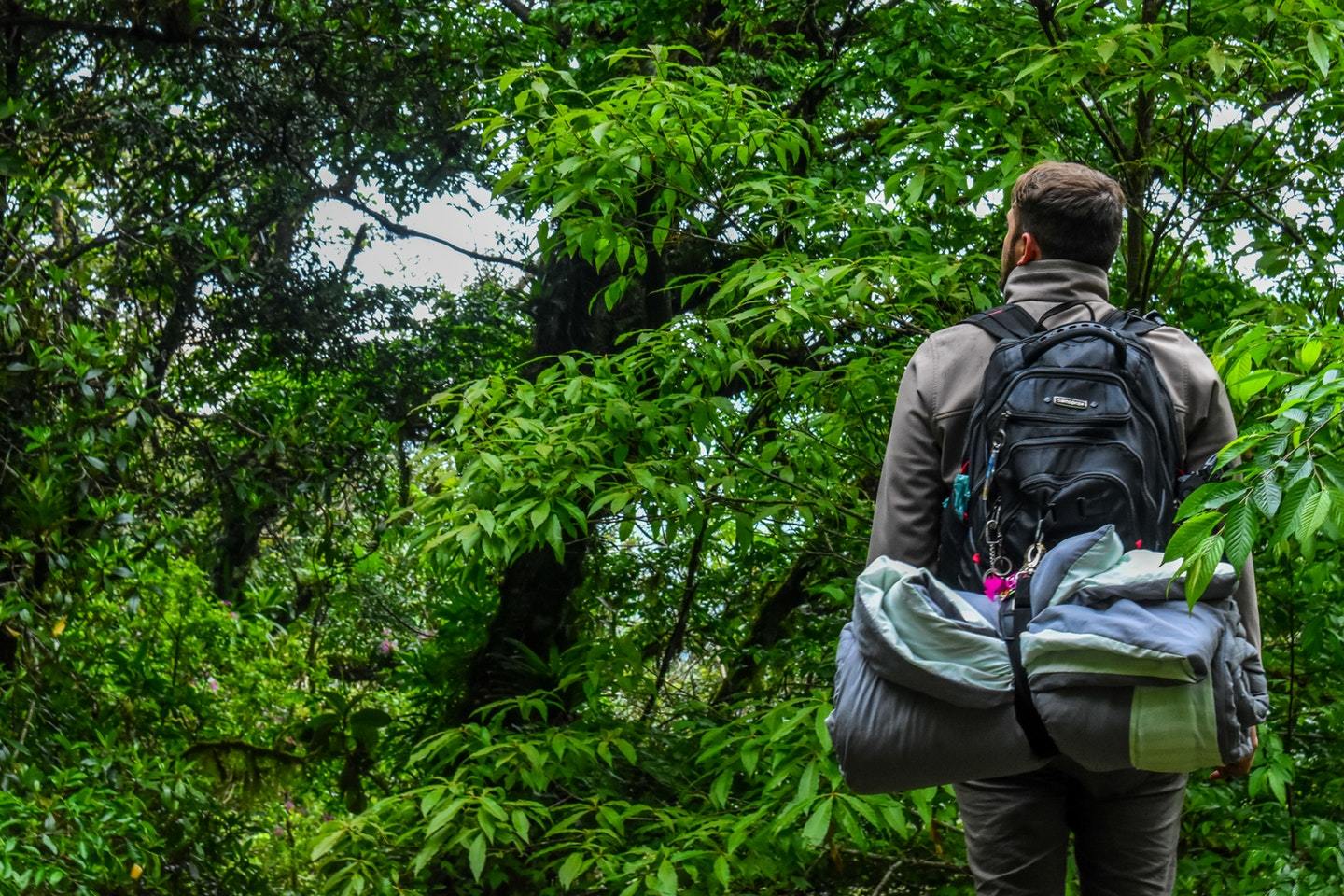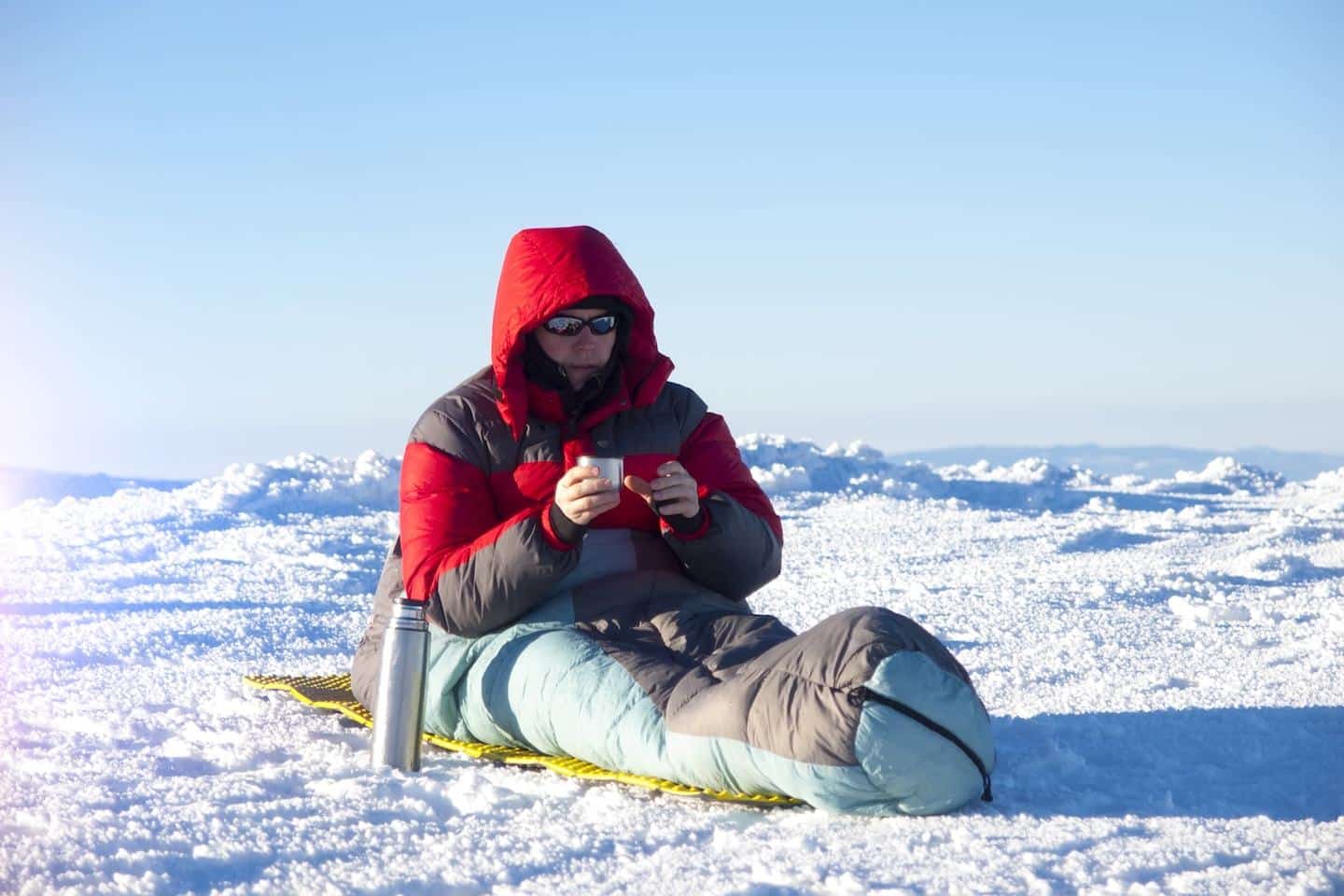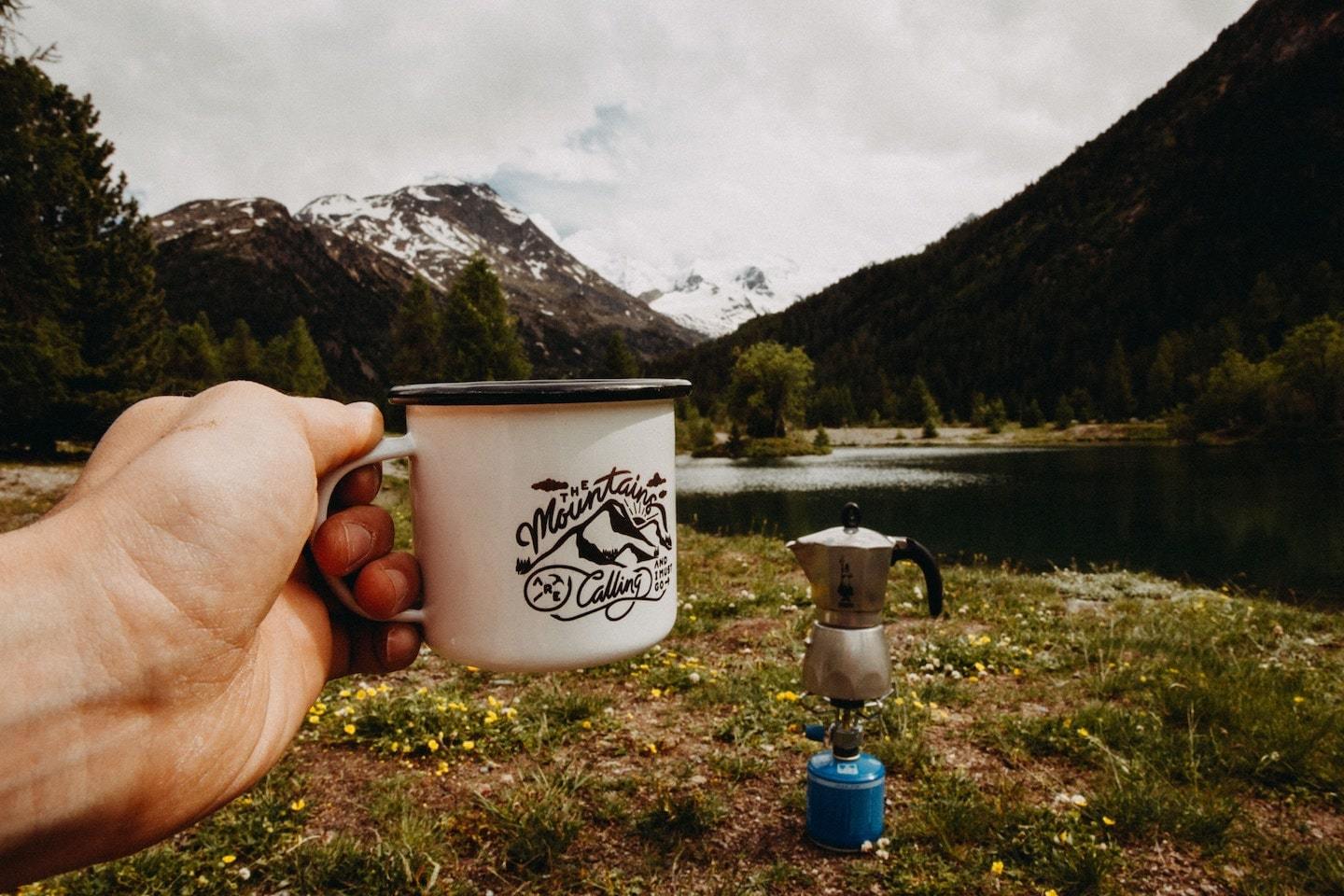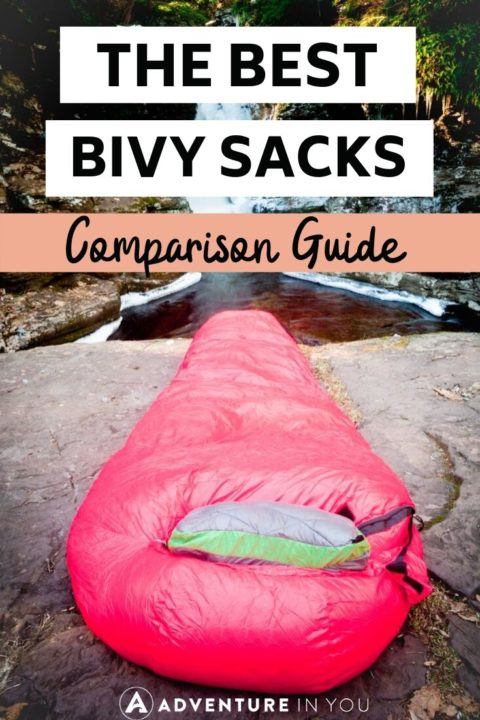While there are countless ways to seek shelter in the great outdoors, a bivy sack (more formally called a “bivouac sack”) is one of the most practical options. Lightweight, compact and easy to set up and pack away, bivies are the ultimate place to sleep on quick outdoor overnights. You’ll be ultra cozy in the mummy like body while being protected from rain and snow as well as any creepy crawlies on the ground next to you.
Keep reading to discover why you absolutely need a bivy sack and five of the best bivy sacks available today!
View Contents
Our Picks for Best Bivy Sacks 2024
- Best Bivy Sack for Cold Weather Camping: Outdoor Research Alpine
- Best Bivy Sack for Warm Weather Camping: Outdoor Research Bug
- Most Comfortable Bivy Sack: Black Diamond Bipod
- Best Budget Bivy Sack: Sierra Designs Backcountry
- Best Minimalist Bivy Sack: Rab Alpine
Bivy Sacks: Comparison Table
| Bivy | Price | Weight | Packed Size (inches) | Reviews |
|---|---|---|---|---|
| Outdoor Research Alpine | $$$ | 20.7 oz | 4" x 15.5" | Read Reviews |
| Outdoor Research Bug | $ | 16 oz | 4" x 14" | Read Reviews |
| Black Diamond Bipod | $$$$ | 28 oz | 6" x 15" | Read Reviews |
| Sierra Designs Backcountry | $ | 13.6 oz | 3" x 9.5" | Read Reviews |
| Rab Alpine | $$$ | 16 oz | 4" x 10" | Read Reviews |
What is a Bivy Sack and Why Do You Need One?
A bivy sack is a lightweight tent alternative that you can carry with you on hikes, backpacking trips, or any kind of outdoor overnight where you’ll need shelter. When you’re ready for rest, simply pull out the bivy sack, stick your sleeping bag in it, and voila! You’re now protected from pests, cold and Mother Nature’s wrath.
Tents are awesome, but bivies are even better, especially for solo travelers looking to shed as much weight from their pack as possible. They’re great for adventuring in the backcountry by yourself or taking long distance bike trips with undetermined returns.

Bivies are great in case of emergency as they’ll protect you from the elements and cold, and ideal for minimalists who don’t need all the bells and whistles that come with a tent. Bivies have possibly the easiest set up on the planet. Forget the days of fumbling with poles and latches, trying to get your tent to stand when all you want is sleep!
Finally, bivies are the best for all the star lovers like me, as you can fall asleep searching for constellations instead of staring at a fabric roof.
Psst...Want in on a Secret? 🤫

We've scoured the internet for the best ALL-AROUND travel shoe and Tropicfeel wins by far. We've taken ours through rivers, jungles, and cities and they're still alive and kickin'. Check them out below.
Types of Bivy Sacks
There are three main types of bivy sacks that you’ll come across on your search for one that’s perfect for you. Here’s a quick lowdown on each type.
Four-Season Bivy Sacks
Four-season bivies can be used year-round and are more similar to tents than just a standard sack.
This kind of bivy often comes with poles or stakes to create more room around your head, and is made of tough and durable materials. Four-season bivies tend to be the most weatherproof by design and can be used in a wide range of conditions.
The one downside to four-season bivy sacks is that they tend to be much heavier than minimalist options.
Ultralight Bivy Sacks
On the other end of the spectrum, you’ve got your ultralight bivies which are designed with minimalism in mind. These bivies don’t have any poles but are instead ultralight and packable. They’re great to have with you in case you need an emergency shelter.
Bug Net Bivy Sacks
Finally, you’ve got your bivies to protect you from bugs.
This type of sack also tends to be lightweight and is good for using during fair, dry weather. These bivies will keep the bugs out with the built-in net, but don’t protect much when it comes to weather.
How to Choose a Bivy Sack
Because a bivy qualifies as a wilderness shelter, there are some prime considerations to keep in mind when choosing a bivy sack that’s right for you.
Weather Resistance
When it comes to bivies, weather resistance is a must. Even if you’re planning to use it in dry conditions, Mother Nature is notoriously unpredictable and you never know when a midnight downpour will strike.
Even if it’s not raining or snowing at the moment, you may find that the ground you decide to sleep on is wet. Without weatherproofing, you’ve got a soggy sleeping bag from the moisture seeping through.
Weatherproofing also helps insulate a sleeping bag which can be great for winter camping, but also detrimental when it comes to condensation. Because the weatherproofing keeps water out, the fabric also has a hard time letting the air that’s inside the bag out. This leads to moisture forming inside of the sack.
Bivies that have high breathability are better when it comes to condensation but they won’t protect you from the elements as well. This is the trade-off when it comes to ultra weatherproof bags and is something to keep in mind when weighing your options.

Weight
Besides protecting you from the elements, bivy sacks are ideal for shedding weight in your pack. Like all other outdoor gear, bivies come in all different weights. Your choice will depend on what you’ll be using them for.
If you go for a four-season bivy, you can expect that it’s going to be a bit heavier than if you opt for an ultralight shell. You should also keep in mind that bivy sacks with poles add more weight than those which simply unroll.
Ventilation
One of the most important factors of a bivy is that it is well-ventilated. It can already be a bit uncomfortable to be restricted in movement while inside your bivy sack so the last thing you want is condensation inside as well.
Choose a bivy that you can unzip with ease when you need air. It should also have proper ventilation towards your head so that air can escape as easily as new air can be let in.
You’ll find that bug net bivies tend to have the best ventilation as there’s a mesh panel over your face, whereas four-season bivies can get a little bit stuffy.
It also helps if your bivy has a pole or can be staked out to give you more space around your head which increases airflow. Plus, no one likes to sleep with a piece of fabric on their face.
Size (Unrolled and Packed)
When it comes to bivy sacks, size can mean two things.
For starters, it can be the size of the sack when it’s unrolled. Is it long enough to fit your body? Wide enough for your sleeping bag to fit inside as well? Is there a foot box or does it taper out at the end? These are all things to look for when it comes to the size of the sack.
On the other hand, size can also refer to how big the bivy is when it’s packed up. This is an extremely important consideration because the packed size will determine how much space it will take up in your backpack.
If you’re trying to make more room in your bag, you’re going to want to look at the pack size to make sure that it’s indeed as compact as you need it to be.
Poles
As mentioned, bivies come in many shapes and sizes. In some cases, they’re essentially a sheet of waterproof material that gets wrapped around your sleeping bag so you can sleep without the fear of rain. On the other hand, less minimalist designs create more of a cocoon for camping in cold weather and harsher conditions.
The latter type of bivy sack often uses poles or hoops which create a mini tent-like atmosphere inside the sack. They give you some more storage space and room to move around, as well as the ability to shed water and snow with ease.
The downside? They’re much heavier and more expensive as well.
This decision totally depends on what you plan to use your bivy sack for. If you’re looking for a more permanent tent alternative, you may want to go for something with poles. But if you want a bivy that’s for quick, infrequent trips, a poleless one will probably serve you just fine.
Comfort
Finally, you’re going to want to pick a bivy sack that’s as comfortable as possible. While it may not be the Ritz, the right bivy can sure feel plush and cozy, especially after a long day of adventuring.
Comfort can mean a few different things, but the key things to keep in mind are protection from insects, a decent amount of wiggle room once inside, ease of set up and packability, and finally anything extra that makes the bivy special like pockets, straps or hidden compartments.

Best Bivy Sacks 2024
Here are reviews of best five bivy sacks on the market right now. Each has some crazy cool upsides, with some challenging downsides as well. Keep reading to find one that’s best for you!
Outdoor Research Alpine
Best Bivy Sack for Cold Weather Camping
Pros: Great for intense weather | Weatherproof but breathable | Hooped pole | Mosquito net | Sleeping bag straps & mesh pockets
Cons: Heavy | May be too warm for milder weather
One of the best bivy sacks for extreme weather conditions, the Outdoor Research Alpine will keep you warm and dry no matter what’s going on outside.
This bivy comes complete with 3-layer GORE-TEX respiration-positive fabric. This means that it keeps the rain and snow out without trapping condensation inside — total win! The floor is also crafted from hydroseal-coated waterproof fabric to ensure nothing seeps inside, no matter how wet the ground is.
The seams on this bivy are fully taped so nothing will be getting inside without your knowledge. The overhead hooped pole makes for a roomy and comfortable night’s sleep.
This bivy is awesome because it’s spacious, comes with a mosquito net and storm flap, and even has straps for your sleeping pad and mesh pockets inside for your valuables! Coming in at 30 ounces, this is ideal for carrying on any adventure.
Just keep in mind, that it may be a little warm for milder climates.
Outdoor Research Bug
Best Bivy Sack for Warm Weather Camping
Pros: Hooped pole at head for extra room | Waterproof floor | Lightweight
Cons: Can only be used in warm, dry weather
If you like the idea of the Alpine but are looking for something for warm, dry weather, the Bug Bivy certainly does the trick.
Essentially a giant mosquito net to put your sleeping bag inside, you’ll certainly get a good night’s sleep knowing all the creepy crawlies are staying far away from you. The floor of this bivy is still hydroseal-coated waterproof nylon so you won’t have to worry about getting wet from the ground up. But keep in mind that this bivy should only be used in dry conditions!
The hooped pole near the top of the bivy sack is great for providing some extra space while inside. The sleeping pad straps make sure that nothing wiggles around while you try to catch some shuteye.
This bivy is about half the weight of the Alpine but is still crafted from the same durable materials so you’ll definitely be able to stash it in your pack with ease. You’ll find this bivy is exceptionally easy to set up and pack away, but you may end up being quite chilly if you use it in cold, wet weather.
Black Diamond Bipod
Most Comfortable Bivy Sack
Pros: Roomy | Mesh and fabric cover | Single pole
Cons: Expensive | Heavy
A high-tech bivy that will feel (and look) much like a tent when you’re inside, the Black Diamond Bipod is great for longer wilderness excursions. There are tons of added benefits to this bivy sack that make it outstandingly comfortable and cozy to use.
First, this bag is made of waterproof, seam-taped ToddTex material, aka it’s crazy waterproof and durable so you won’t have to worry about leaks or seepage while in use.
The bivy also utilizes a single pole to maximize headroom without adding a ton of extra weight. When inside, you’ll have no problem breathing comfortably as ventilation is abundant. Plus, there were no sacrifices made between waterproofing and breathability.
One of the best parts about this bivy is that there’s a large mesh panel on the top of the bag that you’re able to completely zip over you. When the outer layer of fabric is unzipped with the mesh still up, you’ll be protected from mosquitos while still being able to see the night sky. Does it get any better than that?
However, keep in mind that this sack is certainly on the pricer side and is a bit heavy as well.
Read More: Ultimate Guide to the Best Lightweight Sleeping Bags [UPDATED for 2024!]
Sierra Designs Backcountry
Best Budget Bivy Sack
Pros: Good price | Lightweight | Versatile | Mesh net over face
Cons: Less durable | No pole so fabric rests on face | May run short
A super reasonably priced bivy that gets the job done, this option is lightweight and versatile, making it perfect for any kind of trip you’re headed to.
Weighing only 14 ounces and made of ripstop nylon, this Sierra Designs bivy sack is the perfect lightweight companion to fit in your pack. It packs down to only 3 x 10 inches but still has all the main features of a top-of-the-line bivy.
This sack is completely waterproof while still being breathable enough to let condensation escape while you’re inside. There’s also a bug net option that allows you to pull mesh over your face (while sleeping on warmer nights) to let air in and keep mosquitoes out.
However, there are a few downsides that come with this bivy sack.
First, there’s no pole in this bivy. This is great for weight but means that there’s going to be fabric on your face while you sleep. It’s also less durable than other bivy options at a higher price. Finally, it’s on the shorter side, so be sure to pay extra close attention to the measurements before purchasing!
Rab Alpine
Best Minimalist Bivy Sack
Pros: Ultra minimalist | Crazy durable | Super warm
Cons: No pole | On the narrow side | Only really good for winter
For all you minimalist campers, the Rab Alpine is a crazy solid option for top-notch shelter in cold conditions.
This mummy-looking bag is made of lightweight 3-layer eVent fabric. This means it’s great for unpredictable weather like rain or snow, but will still allow condensation to escape.
The floor of the bivy sack is crafted from durable, waterproof materials so you won’t have to worry about it snagging on a stray branch or rock while in use. And while this bivy is exceptionally warm and great for winter, it’s still lightweight, packable, and easy to take on any trip.
The one downside to this sack, besides the fact that it’s best for cold weather rather than all-year, is that inner space is seriously limited when inside. Since there’s no pole or hoop, there’s not a lot of room near the head. Plus, the narrow body may make you feel claustrophobic once you’re all zipped up.
Are you now convinced that bivies are an essential piece of gear that all outdoor enthusiasts should own? Seriously, having one of these is a complete game changer. Hiking and camping without the pain of lugging a heavy tent around? Count me in.
What kind of bivy do you like best? More high-tech or are you a total minimalist? Drop a comment below to let us know and in the meantime, happy camping!
Headed outdoors? Check out our gear guides!
- Ultimate Guide to the Best Hiking Pants for Any Season
- Best Women’s Hiking Boots: The Ultimate List
- Ultimate Guide: Best Backpacking Tents to Buy
Inspired? Pin It!
